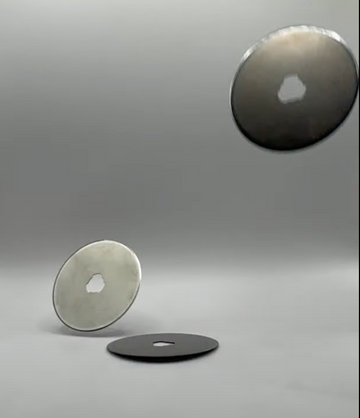If you’ve ever looked at a sewing pattern and thought, “This would be perfect if only...” congratulations! You’re ready to start pattern hacking.
Pattern hacking is exactly what it sounds like: taking a sewing pattern and tweaking it to make it more you. Whether you want to combine your two favorite patterns into one super-garment, move a zipper for easier access, or draft your own sleeves of drama, pattern hacking opens up a whole world of custom possibilities.
I most recently hacked the Butterick B6993 to add a longer and puffier sleeve, and to get rid of the under bust gathering that didn't flatter me. You can watch the full explanation here.
Here’s how to start hacking patterns; plus several methods to get your creative brain buzzing and your rotary cutter slicing.
NOTE: for ALL of these methods, you should trace your original pattern piece first and then get drawing, slicing, etc. That way, you'll always have the original to refer back to.
📏 1. Combine Two Patterns
Why: You love the bodice of one dress and the skirt of another. Why choose?
How:
-
Pick two patterns that use the same or similar fabric types. (Stretch-to-stretch, woven-to-woven.) THIS IS IMPORTANT! You're never going to be able to combine a stretch sleeve with a woven bodice! Save yourself!
-
Make sure the waist seam measurements match up—or adjust one to fit the other.
-
Blend by laying the bodice and skirt pieces together at the waist seam and tracing a new full pattern piece. This step is only sometimes necessary. If I'm adding a circle skirt where there was a gathered skirt before, I just swap out one pattern piece for the other. Easy peasy.
Hack Tip: If your skirt has pleats or gathers, you’ll want to mark notches to match your new bodice. It’s a Frankenstein moment, but make it fashion.
🧵 2. Move a Zipper or Closure
Why: A back zipper can be hard to reach. A side zip might be better for your body or your lifestyle.
How:
-
Identify where the closure will be easier or more practical (center front, side seam, etc.).
-
Transfer the seam allowance to the new zipper location.
-
Remove any darts or shaping that would interfere and redistribute them if needed. (See next tip)
Hack Tip: Invisible zippers can go just about anywhere if you're confident with your machine and zipper foot. Want a more vintage vibe? Use a button placket instead.
🧷 3. Move or Redraw Darts
Why: You want a cleaner line, better bust shaping, or just feel like experimenting.
How:
-
Trace your original bodice piece.
-
Draw a line from the existing dart tip to your new dart location (shoulder, armscye, waist, etc.).
-
Cut and pivot the dart to the new location, then true the lines.
Hack Tip: This is called the “slash and spread” method. It's a little like playing geometry but with thinner paper.
✏️ 4. Add (or Subtract) Volume
Why: Want a puff sleeve? A swishier skirt? A peplum that goes full flamenco?
How:
-
Trace the piece you want to alter.
-
Slash vertically and/or horizontally, then spread (for more volume) or overlap (for less).
-
Redraw the outer edges smoothly to maintain the shape.
Hack Tip: Start with muslin or scrap fabric to test how much fullness you really want. Big sleeve energy is fun until you knock over your coffee. Ask me how I know.
📐 5. Self-Drafting a New Element
Why: You can’t find a pattern that does exactly what you want.
How:
-
Use your existing garment or pattern as a base (like the armhole of a bodice to draft a custom sleeve).
-
Use a flexible ruler or drape fabric directly on your body/dress form to sketch a shape.
-
Transfer to paper and add seam allowances.
Hack Tip: Keep your expectations low on the first draft and make a test version before cutting into your real fabric. You’re not making a wearable garment yet—you’re making progress.
🖇️ 6. Change the Neckline or Hem
Why: You want a scoop neck instead of a crew. A cropped top instead of a tunic.
How:
-
Redraw the neckline or hem shape on your traced pattern.
-
Add or subtract length as needed.
-
Remember facings or bindings will need to be redrafted too.
Hack Tip: If you’ve got a garment you love the neckline or hem of, trace it and blend that line onto your new pattern piece.
🎨 Final Thoughts: Think Like a Designer
Pattern hacking is more about mindset than skill. You don’t have to be a professional patternmaker, you just need to be curious and willing to experiment.
Start small. Document your changes. Make a muslin. Then enjoy the magic of wearing something that’s truly one-of-a-kind.
You are the designer now.
🧵 Want to try your first pattern hack with confidence?
Make sure you’ve got sharp rotary blades and fresh machine needles on hand—grab your monthly replacement bundle here and never let a dull blade hold back your creative streak.
Happy hacking!
-E






